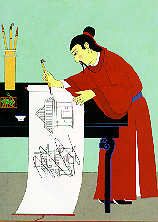


|
The Cricket's Cage.
Stefan Czernecki.
Subject Headings:
Preschool - grade 4 / Ages 4 - 9.
**** /4
|

excerpt:
Hundreds of years ago in China, there lived an emperor of the Ming dynasty named Yongle (Yung-lo). His love of architecture drove him to create an imperial palace the likes of which had never before been seen. Surrounded by a great wall, the complex was called the Forbidden City. To make the structure even more grand, Yongle ordered that plans be drawn to create four towers - one on each corner of the wall.
 As Czernecki explains in his concluding "Author's Note," this
Chinese folktale has its basis in historical fact although the
cricket's role in designing the towers is obviously the "tale"
portion. The book's opening page, reproduced in the "Extract"
above, establishes the conflict. After several months of
unsatisfactory designs, Emperor Yongle threatens Minister Wu
Zhong, "If you do not present a suitable idea within three days
you will lose your head." Repeating the Emperor's threat to
Master Builder Cai Xin, Wu Zhong reduces the period by a day. In
turn, Cai Xin transfers the problem to carpenter Kuai Xiang and
gives him but a single day to produce an appropriate model. When
Kuai Xiang shares the details of his distress with a friend who
sells crickets in the marketplace, the friend gives him a cricket
because "his song will surely bring you good luck and cheer you
up as well." By day's end, Kuai Xiang, although cheered by the
cricket's music, still lacks a design, and, as Kuai Xiang goes to
bed, he says to the cricket, "I do not have long to live...but I
will build you a larger cage and leave you in comfort before I
go." The cricket, unsure that Kuai Xiang will build him the kind
of cage he wants, uses his antennae to paint an appropriate
design. In the morning, an amazed Kuai Xiang finds the plans and
builds the cricket's home, but when Cai Xin sees the cage, he
mistakenly identifies it as the structure the Emperor has sought,
and so a cricket's cage becomes the design for the Forbidden
City's watchtowers.
As Czernecki explains in his concluding "Author's Note," this
Chinese folktale has its basis in historical fact although the
cricket's role in designing the towers is obviously the "tale"
portion. The book's opening page, reproduced in the "Extract"
above, establishes the conflict. After several months of
unsatisfactory designs, Emperor Yongle threatens Minister Wu
Zhong, "If you do not present a suitable idea within three days
you will lose your head." Repeating the Emperor's threat to
Master Builder Cai Xin, Wu Zhong reduces the period by a day. In
turn, Cai Xin transfers the problem to carpenter Kuai Xiang and
gives him but a single day to produce an appropriate model. When
Kuai Xiang shares the details of his distress with a friend who
sells crickets in the marketplace, the friend gives him a cricket
because "his song will surely bring you good luck and cheer you
up as well." By day's end, Kuai Xiang, although cheered by the
cricket's music, still lacks a design, and, as Kuai Xiang goes to
bed, he says to the cricket, "I do not have long to live...but I
will build you a larger cage and leave you in comfort before I
go." The cricket, unsure that Kuai Xiang will build him the kind
of cage he wants, uses his antennae to paint an appropriate
design. In the morning, an amazed Kuai Xiang finds the plans and
builds the cricket's home, but when Cai Xin sees the cage, he
mistakenly identifies it as the structure the Emperor has sought,
and so a cricket's cage becomes the design for the Forbidden
City's watchtowers.
Czernecki's text and illustrations are placed on facing pages with both being effectively bordered with a rich yellow embroidered design, yellow being the colour only the Emperor could wear. Described as "an avid student of Chinese culture and history," Czernecki has employed Chinese mineral and vegetable pigments in creating his illustrations.
A most useful addition to school and public libraries' traditional literature collections.
Highly recommended.
Dave Jenkinson teaches children's and adolescent literature courses at the Faculty of Education, University of Manitoba.

To comment on this title or this review, send mail to cm@umanitoba.ca.
Copyright © 1997 the Manitoba Library Association. Reproduction for personal use is permitted only if this copyright notice is maintained. Any other reproduction is prohibited without permission.
Published by
The Manitoba Library Association
ISSN 1201-9364
TABLE OF CONTENTS FOR THIS ISSUE - September 5, 1997.
AUTHORS | TITLES | MEDIA REVIEWS | BOOKSHELF | BACK ISSUES | SEARCH | HOME